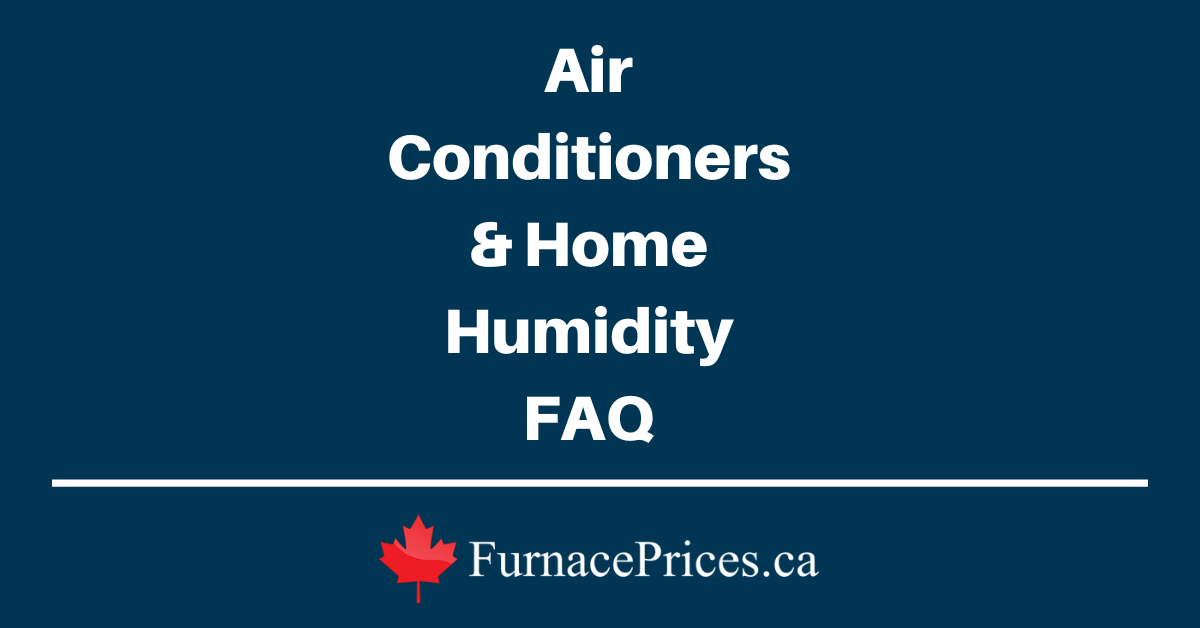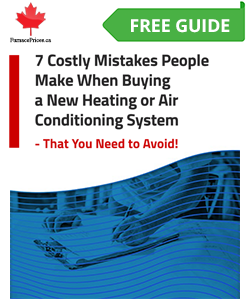Other Top Air Conditioner Buying Resources
- Central Air Conditioner Buying Guide
- Air Conditioner Prices in Canada
- Central A/C Cost Calculator (Get a Quick Rough Estimate)
- Current Local Heating & Cooling System Deals
- Get Free Estimates from Our Certified Local Contractor Partners
How We Evaluate the Best Air Conditioners
- Real customer feedback: We continuously gather and analyze customer feedback and reviews from Canadian homeowners.
- SEER rating: An air conditioner with the right efficiency rating could save you plenty on cooling bills.
- ENERGY STAR®: It’s not necessary to get an air conditioner with ENERGY STAR certification, but ones that qualify are guaranteed to perform and deliver excellent efficiency, and they could be more likely to qualify for rebates.
- Compressor style: Whether the unit has a single-stage, two-stage, or variable-speed compressor will help to determine its price, efficiency, performance, and noise level.
- Warranty: A good warranty can save you lots on repairs and maintenance over the years.
- Features: Some air conditioners are very basic, but some of the higher-end ones come with cutting-edge technologies and cool features.
- Quality and durability: Air conditioners in Canada all meet a certain standard when it comes to quality of construction, but some are built more durably than others.
- Size: Getting an air conditioner that’s the right size for your space can be even more important than all the other factors because a unit that’s the wrong size won’t perform in terms of efficiency, longevity, or cooling capabilities.
- Value versus budget: We said that price isn’t necessarily a top priority, but value certainly is. An expensive top-of-the-line air conditioner isn’t necessarily worth the price if it doesn’t deliver, whereas an affordable entry-level model that performs reliably will be worth every penny.
Best Central Air Conditioners in Canada: Ratings and Reviews from Real Homeowners
Air Conditioners with the Best Prices (by Budget)
- Entry-level: The most affordable and most basic systems, usually single-stage models from brands like York and Goodman, possibly with shorter warranties
- Mid-range: In the middle in terms of price, features, and warranty coverage, single- or two-stage models from brands like Daikin, Amana, and Napoleon
- Top-tier: The priciest models with the highest SEERs, most features, and best warranties; two-stage and variable-speed systems from brands like Lennox and Carrier
| Budget | Brand/Model | Price | SEER | Features |
|---|---|---|---|---|
| Economy | KeepRite N4A7T | $3,500 to $5,500+ | 17 | Two-stage, two-speed fan, durable unit, ENERGY STAR |
| Economy | Goodman GSX16 | $3,500 to $5,500+ | 16 | Single-stage, efficient scroll compressor, ENERGY STAR |
| Economy | York YC2D | $3,500 to $5,500 | 5 | Single-stage with an alloy microchannel coil |
| Mid | Daikin DX16SA | $4,500 to $5,500+ | 16 | Single-stage, excellent warranty, self-diagnostics |
| Mid | Amana ASX16 | $4,500 to $5,500 | 16 | Single-stage, scroll compressor, self-diagnostics |
| Mid | American Standard Silver 14 | $4,500 to $6,000 | 16 | Single-stage, great warranty, ENERGY STAR |
| High | Carrier 24SCA5 | $4,500 to $6,000 | 16.5 | Single-stage, durable unit, refrigerant that doesn’t deplete ozone |
| High | Trane XR14 | $6,000 to $8,500+ | 16 | Single-stage, special compressor and coil |
| High | Lennox Merit 16ACX | $6,000 to $8,500+ | 17 | Two-stage, durable, easier installation |
Air Conditioners with the Best Warranty Coverage
| Budget | Brand and Model/Series | Compressor Warranty | Parts Warranty | Unit Replacement Warranty |
|---|---|---|---|---|
| Economy | Goodman GSXC18, GVXC20, and GSXC16 | Lifetime | 10 years | 10 years |
| Economy | York YXT and YXV | Lifetime | 10 years | N/A |
| Economy | KeepRite C4A7T and CVA9 | N/A | 10 years | 10 years |
| Medium | Amana all premium and some value models | N/A | 10 years | Lifetime |
| Medium | Luxaire AL19 and AL21 | Lifetime | 10 years | N/A |
| Medium | Daikin DX16TC, DX18TC, DX20VC, and Daikin Fit | N/A | 12 years | 12 years |
| Medium | Bryant Evolution Series | 10 years | 10 years | 10 years |
| High | Ruud UA18AZ | 10years | 10 years | 10 years |
| High | American Standard | 12 years | 10 years | N/A |
| High | Carrier Infinity 26 | 10 years | 10 years | 10 years |
| High | Rheem Prestige series and Endeavor Line Prestige Series | 10 years | 10 years | 10 years |
| High | Trane TruComfort Series | 12 years | 10 years | N/A |
Getting the longest-lasting air conditioner warranties
Get Quotes
How soon are you looking to buy?*



Most Energy-Efficient Air Conditioners
| Budget | Brand/Model | SEER | Compressor Style |
|---|---|---|---|
| $4,750 to $7000+ | Napoleon NT 16 | 16 | Single-stage |
| $5,500 to $7,500+ | Keeprite CVA9 / Tempstar TVA9 / Comfortmaker CVA9 / Heil HVA9 | 19 | Variable-speed |
| $5,000 to $7,500+ | Ruud UA17 | 17 | Two-stage |
| $5,000 to $7,500+ | Goodman GSXC18 | 19 | Two-stage |
| $5,500 to $8,500+ | Amana ASXC18 | 19 | Two-stage |
| $5,500 to $8,500+ | Armstrong 4SCU20LX | 20 | Variable-speed |
| $5,500 to $8,500+ | Daikin DX18TC | 19 | Two-stage |
| $5,500 to $8,500+ | Coleman AC21 / Luxaire AL21 | 20 | Variable-speed |
| $6,500 to $8,500+ | American Standard Platinum 18 | 18 | Variable-speed |
| $6,500 to $8,500+ | Rheem RA20 | 20.5 | Variable-speed |
| $6,500 to $8,500+ | York YXT | 19.75 | Two-stage |
| $7,000 to $8,500+ | Bryant 189BNV | 19 | Variable-speed |
| $7,000 to $8,500+ | Lennox XC20 | 20 | Variable-speed |
| $7,000 to $8,500+ | Carrier 19VS | 19 | Multi-speed |
| $7,000 to $8,500+ | Trane XV18 | 18 | Variable-speed |
Best Central Air Conditioners that Meet SEER2 Efficiency Standards
| Brand | Model | SEER2 Rating | Compressor |
|---|---|---|---|
| Napoleon | Premium 14.3 | 14.3 | Single-stage |
| Daikin | DX5SE | 15.2 | Single-stage |
| Amana | ASXH5 | 15.2 | Single-stage |
| Rheem | RA15AZ | 15.2 | Variable-speed |
| Goodman | GSXH5 | 15.2 | Single-stage |
| York | YC2E | 16.5 | Single-stage |
| Luxaire | TCE2 | 16.5 | Single-stage |
| Coleman | TCE2 | 16.5 | Single-stage |
| Heil | H4A6S | 16.5 | Single-stage |
| Comfortmaker | C4A6S | 16.5 | Single-stage |
| Payne | PA7T | 17 | Two-stage |
| Bryant | 127T | 17 | Two-stage |
| KeepRite | N4A7T | 17 | Two-stage |
| Carrier | 24TPA7 | 17 | Two-stage |
| Tempstar | N4A7T | 17 | Two-stage |
| American Standard | Platinum 17 | 17 | Variable-speed |
| Trane | XV17 | 17 | Variable-speed |
| Lennox | xc21 | 19.2 | Two-stage |
Quietest Air Conditioners – Quiet Operation Features
| Brand and Model | Decibel Rating | Special Features |
|---|---|---|
| Goodman GSXS6 | As low as 45 | Quiet fan motor and high-density compressor sound blanket |
| Carrier Infinity 26 24VNA6 | As low as 51 | Silencer System II: a special fan blade and motor design, compressor plate, and special top that muffles noise |
| Bryant Evolution Extreme 26 | As low as 51 | AeroQuiet System II design, compressor sound blanket, quiet-mount compressor grommets, forward-swept fan blade, and soft start/ramp up |
| York Affinity YXV, Coleman AC21, and Luxaire AL21 | As low as 53 | Compressor cloak, composite base pan, and swept-wing fan blade design |
| Rheem Prestige Series RA20/Ruud UA20 | As low as 54 | Special composite base pan that dampens sound |
| Trane XV20i TruComfort | As low as 55 | Blade-down fan design, Climatuff Compressor, and compressor sound insulator |
| Lennox SL28XCV | As low as 56 | SilentComfort: vibration-resistant components, a specially shaped fan blade, and thick insulation |
| KeepRite CVA9, Comfortmaker CVA9, Heil HVA9, and Tempstar TVA9 | As low as 56 | Compressor blanket, aerodynamic fan, and soft mounts for the compressor |
| Goodman GVXC20 | As low as 57 | High-density foam sound control blanket |
| Daikin Fit and DX20VC | As low as 57 | High-density foam compressor sound blanket and sound-control top |
| Amana AVXC20 | As low as 57 | High-density foam compressor sound blanket and sound-control top |
| American Standard Platinum 18 | As low as 54 | Compressor sound insulator |
Important Installation and Maintenance Tips: Getting the Most from Your New Air Conditioner
- Is installed properly
- Is the right size for your house
- Doesn’t get damaged during installation
- Operates at the efficiency level advertised
FAQ
What’s the best air conditioner brand on the market?
It’s easy to get caught up in brand names when you’re looking at air conditioners, but the truth is that the vast majority of the brands on the market in Canada are made by just a handful of manufacturers. The brands we’ve talked about today are some of the most popular in the country, but things like efficiency, durability, warranty, features, and value are all more important than the name on the unit.
Are any air conditioners made in Canada?
Almost none of the major air conditioner brands sold in Canada are actually made by a Canadian company or manufacturer locally, with the exception of Napoleon
How often should I have my air conditioner serviced?
You should have your air conditioner inspected and serviced annually by a professional HVAC technician. Annual maintenance can include cleaning components, tightening parts, recharging the refrigerant, and more, and it will keep your air conditioner performing optimally and efficiently for many years.
What is compressor speed?
Air conditioners are available with single-stage, two-stage, and variable speed compressors. A single-speed compressor has only On and Off settings, so it’s always running at one constant speed or not at all. Two-stage compressors have two speeds, meaning they can operate at a lower or higher setting when they’re running. These are quieter, more efficient, and better at keeping temperatures even. Variable-speed compressors have many speeds and can make incremental adjustments to the speed to increase efficiency, reduce noise, and keep every corner of your house at the same temperature all the time.
What’s an ECM motor?
ECM stands for electronically commutated motor. The main benefit of an ECM motor is that it varies the fan speed using electronic controls, so it’s quieter and more efficient than a single-speed motor.
Get Quotes
How soon are you looking to buy?*











